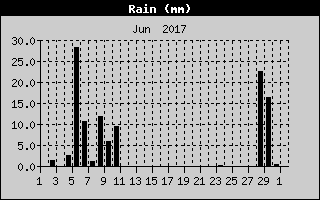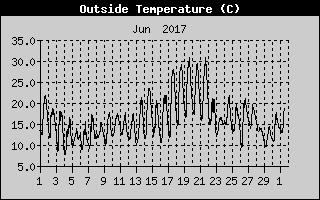(Jan 2018: updated to compare with Usk and not Ross-on-Wye)
January 2017 was a little below normal as far as temperature and rainfall were concerned and the average maximum temperature of 7.0°C was 1.1°C below the Usk average for January of 8.1°C. The minimum temperature sank below 0°C on thirteen days. The warmest day was the 11th (max = 10.5°C) and the coldest was the 21st with a low of -3.8°C.
The measured rainfall was 89.4 mm, 70% of the Usk* average for January of 127.6 mm, with 49 mm falling in the last five days of the month. Rain was measured on 18 days in the month, the wettest being the last day when 17.4 mm fell. There was an eight day period in which no significant rain fell (>0.2 mm per day) between the 19th and the 26th.
February 2017 was normal with respect to temperature and, apart from the first two wet days of the month (1st and 2nd), relatively dry too. The month had 4 frosty mornings in all, and there were no days when frost lasted throughout. Overall, the average maximum temperature of 8.0°C was 0.5°C below the Usk average for February of 8.5°C.
There were ten days on which no significant rain (0.2 mm or less) fell, and a total monthly rainfall of 79.6 mm was 9% below the Usk* average for February of 87.4 mm.
March 2017 was warmer and a little wetter than usual. Overall, the average maximum temperature of 11.9°C was 0.8°C above the Usk average for March of 11.1°C and there were no days of frost as well.
There were 17 days on which rain fell (>0.2 mm), the wettest being the 22md on which 19.0 mm fell. The total rainfall of 96.4 mm was 16% above the Usk* average for March of 83.1 mm.
April 2017 was a little warmer and was much drier than usual. Overall, the average maximum temperature of 14.6°C was 0.6°C above the Usk average for April of 14.0°C with a peak of 21.1°C on the 9th, the minimum temperature being 0.0°C on the 25th.
There were 25 days when no rain (or a trace) fell, the wettest days being the first and last days when 5.2 mm fell each time. It was much drier overall than usual with the total rainfall of 16.2 mm being only about a quarter of the Usk* average for April of 67.5 mm.
May 2017 saw 19 days on which no significant rain fell. The total rainfall of 65.0 mm was 9% below the Usk* average for May of 71.5 mm, much of it falling on six consecutive days (12th to 17th).
Maximum temperatures exceeded 20°C on eight days with a high of 25.7°C on the 16th. May was warm overall as a result, and the average maximum temperature of 18.0°C was 0.5°C above the Usk average for May of 17.5°C.
June 2017 had two very wet spells which sandwiched a period of 17 consecutive days without significant rain (the dictionary definition of a drought is for 15 such days) and during which temperatures were unseasonably high.
 The Penallt total rainfall of 110.0 mm was just under twice the Usk* June average of 60.2 mm with the 5th being the wettest day with 28.2 mm of rain. There were 19 days in the month when no measurable rain fell too.
The Penallt total rainfall of 110.0 mm was just under twice the Usk* June average of 60.2 mm with the 5th being the wettest day with 28.2 mm of rain. There were 19 days in the month when no measurable rain fell too.
Maximum temperatures  were overall above average during this period, exceeding 20°C on thirteen days with a maximum of 30.8°C on both the 19th and the 21st. This temperature equals the second highest in Penallt since records began six years ago, the highest being 31.2°C on July 19th 2016.
were overall above average during this period, exceeding 20°C on thirteen days with a maximum of 30.8°C on both the 19th and the 21st. This temperature equals the second highest in Penallt since records began six years ago, the highest being 31.2°C on July 19th 2016.
The month had two markedly cool spells, the last few days being noticeably cold. Overall, the average maximum temperature of 20.5°C was 0.2°C above the Usk* average for June of 20.3°C.
July 2017 was a little cooler than average and was much wetter than average too. The total rainfall of 106.4 mm was 70% above the Usk* average for July of 62.6 mm. Despite this, there were 19 days on which no measurable rain fell.
The average maximum temperature of 21.5 °C was 0.8 °C below the Usk average for July of 22.3 °C; there were seven days when the temperature exceeded 25 °C.
August 2017 was much cooler than usual but closer to average in terms of rainfall. The total rainfall of 70.0 mm was just under the Usk* average for August of 73.9 mm and there were 15 days on which no significant rain (>0.2 mm) fell, including a spell of seven consecutive days (22-18 incl) on which no rain fell at all.
The average maximum temperature of 19.9 °C was 2.2 °C below the Usk average for August of 22.1 °C, the warmest day being the 28th (24.7 °C). The temperature was 20 °C or more on 15 days.
September 2017 was unremarkable regarding rainfall and temperature. There were only 5 days without rain overall (defined as 0.2 mm or under) with many days being dull and damp but without too much precipitation: the total rainfall was 70.8 mm, some 13% below the Usk* average for September of 81.2 mm.
The month was cooler than average, with the mean maximum temperature of 17.3 °C being 1.9 °C below the Usk average for September of 19.2 °C. The highest was 21.0 °C on the 1st and the lowest of 14.2 °C occurred only two days later on the 3rd.
October 2017 was of near average temperature and drier than usual. The average maximum temperature of 15.2°C was 0.2°C above the Usk average for October of 15.0°C.
There were 15 days on which no significant rain was recorded, making it a very dry month overall, and the total rainfall of 88.4 mm, was 70% of the Usk* average for October of 126.3 mm, much the wettest day being the 19th on which 45.6 mm fell, over half the month’s total.
November 2017 was much drier than usual but finished with a spell of colder weather. The average maximum temperature of 10.3°C was 0.7°C below the Usk average for November of 11.0°C. Several days had ground frosts but the air temperature only dropped to zero on the 30th. Maximum temperatures ranged between 14.4°C on the 1st and 4.7°C on the 30th.
Measurable rain was recorded on 16 days and there were two days when over 10 mm was recorded, but there were no very wet days at all. The total rainfall of 59.0 mm was 52% of the Usk* average for November of 113.7 mm.
December 2017: With its two significant periods of snow, December 2017 was colder yet had no more precipitation than usual overall. The average maximum temperature of 7.5°C was 0.9°C below the Usk average for December of 8.4°C. The maximum temperature exceeded 10°C on 8 days and there were 7 days of air frost too.
The coldest temperature was -3.6°C on the 12th (in Pentwyn, whereas it dropped to -8.9°C in Monmouth at the same time).
There were 11 days when no significant rain was recorded (<0.2 mm); the total rainfall was 121.4 mm, almost exactly the Usk* average for December of 121.9 mm.
20 cm of snow depth was recorded in Pentwyn on the 10th and a further 7 cm on the 27th.
Click the button below for an Excel file giving daily data for 2017:-
* Usk is the nearest Met Office station for which long term averages (1981-2010) are available.